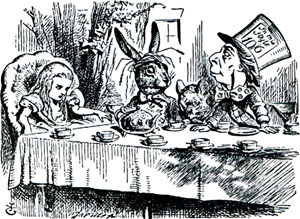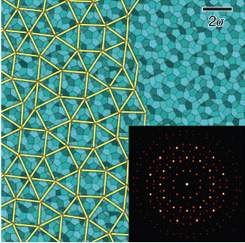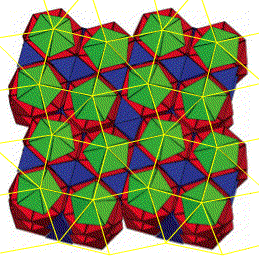This month's topics:

Image from Victorian Web. According to Melanie Bayley, the Mad Hatter's tea party is a farcical allegory of Hamilton's quaternion theory.
The New Scientist for December 16, 2009 ran "Alice's
adventures in algebra: Wonderland solved," by Melanie Bayley.
Bayley's DPhil research in Victorian literature led her to
analyze the differences between Lewis Carroll's first,
hand-lettered, version of
"Alice's Adventures Under Ground" (1864) and the better
known "Alice's Adventures in Wonderland" (now usually "Alice in
Wonderland") published a year later. The newer version is almost
twice as long as the original, which lacks some of the best-known
episodes: the Cheshire Cat, the Duchess's Baby and the Mad Hatter's
Tea Party.
Bayley's thesis is that Carroll took advantage of the
opportunity to poke additional fun at some of the new mathematics of
the period. In particular she mentions "the Mad Hatter's tea party,
which explores the work of the Irish mathematician William Rowan Hamilton."
Hamilton had hypothesized that the fourth coordinate in his quaternions
was connected with time (Lectures on Quaternions, 1853); and in fact
Time is the missing guest at this party. "the members of the Hatter's tea party represent three terms of a quaternion, in which the all-important
fourth term, time, is missing. Without Time, we are told, the characters are stuck at the tea table, constantly moving round to find clean cups and saucers.
Their movement around the table is reminiscent of Hamilton's early attempts to calculate motion, which was limited to rotatations in a plane before he added time to the mix."
There is some play on non-commutativity and
then "When the scene ends, the Hatter and the Hare are trying to put the Dormouse into the teapot. This could be their route to freedom. If they could only lose him, they could exist independently, as a complex number with two terms."
Bayley's piece is available online.

The "wizard's clock" gives a convenient way of organizing the 52 cards in a standard deck into three 17-card supersuits (plus the Ace of Spades); they correspond to the three concentric rings.
One of Colm Mulcahy's mathematical card tricks was featured in John Tierney's New York Times blog for December 24, 2009. The item was written by Pradeep Mutalik. The trick involves three people: the victim V, the accomplice A and the wizard. V selects four cards from a deck; A examines them, returns one to V and places the other 3 in a row on the table, some face-up, some face-down. He then telephones the wizard and tells him exactly what is showing on the table. Based on this information alone, the wizard correctly identifies the card held by V. The explanation, which involves binary numbers, modular arithmetic and the pigeonhole principle, is given in full on the blog. For other card tricks with interesting mathematical structure see Colm's October 2000 feature column on this site.
Packing tetrahedra into a quasicrystal.
Analysis of the quasi-crystalline structure of tetrahedron packing at density 0.8324. In this slice, the edges of the turquoise pentagons join centers of nearest-neighbor tetrahedra. The pentagons and their interstices can be grouped into squares, triangles and rhombs (yellow lines) forming part of a non-periodic tiling of the plane. The diffraction pattern generated by the packed solid (inset) has 12-fold rotational symmetry, known to be incompatible with spatial periodicity. σ is the edge length of a tetrahedron. Image from Nature 462 775, used with permission.
Tetrahedra, unlike cubes, cannot fit together perfectly
to fill 3-dimensional
space; but there has been an ongoing competition to find the most
efficient way of packing them. Last September's column picked up a Nature article in which
Sal Torquato and Yang Jiao described inter alia a packing of
tetrahedra with density φ = 0.7820, a record. Later work by
the same authors (Phys. Rev. E 80 041104)
boosted the best density to 0.8230. Tetrahedron packings reported
in the December 10 2009 Nature by Sharon Glotzer
and collaborators
break this record by achieving densities of
0.8324 and 0.8503. The packings, and the method by which
they were discovered, are of interest themselves.
In a Monte-Carlo simulation using a suspension of
of a large number (8000) of tetrahedra, a phase change occurs
as pressure is increased, leading to the
packing with φ = 0.8324 represented above; it
is part of a quasi-crystal
(the diffraction pattern it generates has 12-fold symmetry,
ruling out spatial periodicity). The packing with φ = 0.8503
(see below) has the same local structure as the quasi-crystal
but is periodic; its slices correspond to the Archimedean snub square
tiling 43433.
Late-breaking news: the record has been broken
again. Kenneth
Chang in the January 4 2010 New York Times ("Packing
Tetrahedrons, and Closing In on a Perfect Fit") reports on
preprints raising φ to 0.8555
(Torquato and Jiao,
posted on December 21) and then to 0.8563
(Elizabeth R. Chen, Michael Engel, Sharon Glotzer, posted January 5).

The periodic approximant to the quasi-crystal shown above has density φ = 0.8503. Here part of the 43433 Archimedean tiling of the plane (yellow) has been superimposed on the image of 2 slices of the packing. Adapted from Nature 462 775.
A weekly math column in the New York Times online. January 31, 2010 was the first posting in what promises to be a weekly series of columns, focused on mathematics, in the "Opinionator" blog-site of the online New York Times. The author will be Steven Strogatz (Applied Mathematics, Cornell), who recently published "The Calculus of Friendship" (Princeton, 2009; excerpts available in PDF format as a reprint from Thought and Action, the NEA's Higher Education Journal). Strogatz's first column, "From Fish to Infinity," starts his program of "writing about the elements of mathematics, from pre-school to grad school, for anyone out there who'd like to have a second chance at the subject -- but this time from an adult perspective."